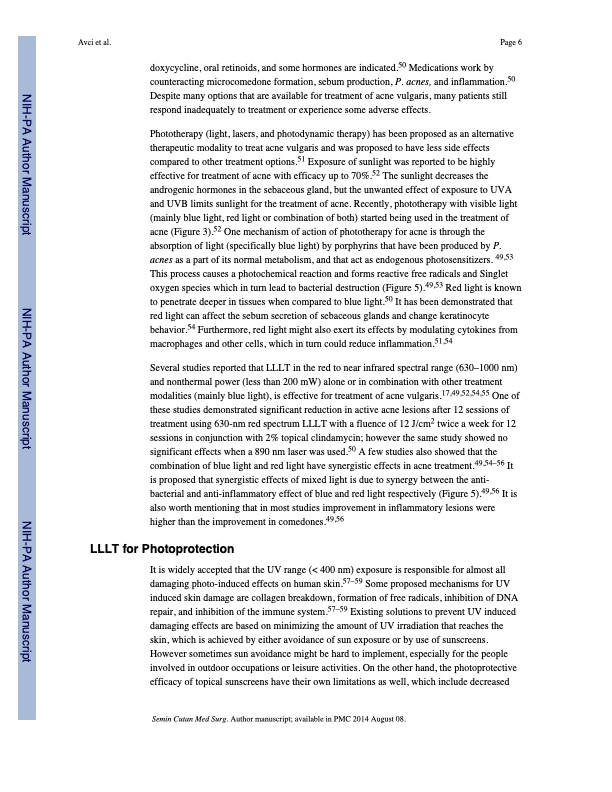
PDF Publication Title:
Text from PDF Page: 006
Avci et al. Page 6 doxycycline, oral retinoids, and some hormones are indicated.50 Medications work by counteracting microcomedone formation, sebum production, P. acnes, and inflammation.50 Despite many options that are available for treatment of acne vulgaris, many patients still respond inadequately to treatment or experience some adverse effects. Phototherapy (light, lasers, and photodynamic therapy) has been proposed as an alternative therapeutic modality to treat acne vulgaris and was proposed to have less side effects compared to other treatment options.51 Exposure of sunlight was reported to be highly effective for treatment of acne with efficacy up to 70%.52 The sunlight decreases the androgenic hormones in the sebaceous gland, but the unwanted effect of exposure to UVA and UVB limits sunlight for the treatment of acne. Recently, phototherapy with visible light (mainly blue light, red light or combination of both) started being used in the treatment of acne (Figure 3).52 One mechanism of action of phototherapy for acne is through the absorption of light (specifically blue light) by porphyrins that have been produced by P. acnes as a part of its normal metabolism, and that act as endogenous photosensitizers. 49,53 This process causes a photochemical reaction and forms reactive free radicals and Singlet oxygen species which in turn lead to bacterial destruction (Figure 5).49,53 Red light is known to penetrate deeper in tissues when compared to blue light.50 It has been demonstrated that red light can affect the sebum secretion of sebaceous glands and change keratinocyte behavior.54 Furthermore, red light might also exert its effects by modulating cytokines from macrophages and other cells, which in turn could reduce inflammation.51,54 Several studies reported that LLLT in the red to near infrared spectral range (630–1000 nm) and nonthermal power (less than 200 mW) alone or in combination with other treatment modalities (mainly blue light), is effective for treatment of acne vulgaris.17,49,52,54,55 One of these studies demonstrated significant reduction in active acne lesions after 12 sessions of treatment using 630-nm red spectrum LLLT with a fluence of 12 J/cm2 twice a week for 12 sessions in conjunction with 2% topical clindamycin; however the same study showed no significant effects when a 890 nm laser was used.50 A few studies also showed that the combination of blue light and red light have synergistic effects in acne treatment.49,54–56 It is proposed that synergistic effects of mixed light is due to synergy between the anti- bacterial and anti-inflammatory effect of blue and red light respectively (Figure 5).49,56 It is also worth mentioning that in most studies improvement in inflammatory lesions were higher than the improvement in comedones.49,56 LLLT for Photoprotection It is widely accepted that the UV range (< 400 nm) exposure is responsible for almost all damaging photo-induced effects on human skin.57–59 Some proposed mechanisms for UV induced skin damage are collagen breakdown, formation of free radicals, inhibition of DNA repair, and inhibition of the immune system.57–59 Existing solutions to prevent UV induced damaging effects are based on minimizing the amount of UV irradiation that reaches the skin, which is achieved by either avoidance of sun exposure or by use of sunscreens. However sometimes sun avoidance might be hard to implement, especially for the people involved in outdoor occupations or leisure activities. On the other hand, the photoprotective efficacy of topical sunscreens have their own limitations as well, which include decreased Semin Cutan Med Surg. Author manuscript; available in PMC 2014 August 08. NIH-PA Author Manuscript NIH-PA Author Manuscript NIH-PA Author ManuscriptPDF Image | Low-level laser (light) therapy (LLLT) in skin: stimulating, healing, restoring

PDF Search Title:
Low-level laser (light) therapy (LLLT) in skin: stimulating, healing, restoringOriginal File Name Searched:
nihms430657.pdfDIY PDF Search: Google It | Yahoo | Bing
Cruise Ship Reviews | Luxury Resort | Jet | Yacht | and Travel Tech More Info
Cruising Review Topics and Articles More Info
Software based on Filemaker for the travel industry More Info
The Burgenstock Resort: Reviews on CruisingReview website... More Info
Resort Reviews: World Class resorts... More Info
The Riffelalp Resort: Reviews on CruisingReview website... More Info
| CONTACT TEL: 608-238-6001 Email: greg@cruisingreview.com | RSS | AMP |